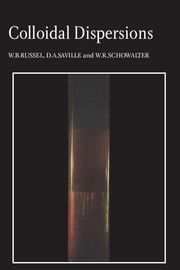Book contents
- Frontmatter
- ACKNOWLEDGEMENTS
- Contents
- Preface
- Units and physical constants
- Mathematical symbols
- 1 A Survey of Colloidal Dispersions
- 2 Hydrodynamics
- 3 Brownian Motion
- 4 Electrostatics
- 5 Dispersion forces
- 6 Forces due to soluble polymer
- 7 Electrokinetic phenomena
- 8 Electrostatic stabilization
- 9 Polymeric stabilization
- 10 Equilibrium phase behavior
- 11 Particle capture
- 12 Sedimentation
- 13 Diffusion
- 14 Rheology
- Appendix A Measured properties
- Appendix B Vector and tensor notation
- Author index
- Subject index
9 - Polymeric stabilization
Published online by Cambridge University Press: 05 August 2012
- Frontmatter
- ACKNOWLEDGEMENTS
- Contents
- Preface
- Units and physical constants
- Mathematical symbols
- 1 A Survey of Colloidal Dispersions
- 2 Hydrodynamics
- 3 Brownian Motion
- 4 Electrostatics
- 5 Dispersion forces
- 6 Forces due to soluble polymer
- 7 Electrokinetic phenomena
- 8 Electrostatic stabilization
- 9 Polymeric stabilization
- 10 Equilibrium phase behavior
- 11 Particle capture
- 12 Sedimentation
- 13 Diffusion
- 14 Rheology
- Appendix A Measured properties
- Appendix B Vector and tensor notation
- Author index
- Subject index
Summary
Introduction
As suggested in Chapter 6, the adsorption or anchoring of polymer onto the surface of colloidal particles provides an alternate means of imparting stability. Indeed, polymeric stabilization was exploited by the ancient Egyptians as early as 2500 bc (Napper, 1983, §2.1). They formulated inks by dispersing carbon black particles in a solution of naturally occurring polymer such as casein or gum arabic. Adsorption of the polymer onto the carbon black maintained the dispersion and also allowed redispersion after drying.
Several reasons persist for using polymeric, instead of electrostatic, stabilization. In some aqueous systems, electroviscous effects and the accompanying sensitivity to electrolyte concentration may be undesirable. In non-aqueous solvents with low dielectric constants, and surface charge densities typically one to two orders of magnitude smaller than in water, electrostatic repulsion frequently does not suffice. In addition, polymeric stabilization can be more robust than the electrostatic mode, providing stability for a longer time and at higher solids concentrations. When flocculation or phase separation does occur, it is normally reversible, i.e. a suitable change in the solvent conditions will redisperse the particles spontaneously.
Napper's (1983, §2.4) review of early studies indicates the evolution in the nature of the polymers used for this purpose. Work in the nineteenth century, and the early part of the twentieth, dealt with aqueous systems and employed biopolymers that were generally globular, crosslinked, or highly branched.
- Type
- Chapter
- Information
- Colloidal Dispersions , pp. 310 - 328Publisher: Cambridge University PressPrint publication year: 1989
- 2
- Cited by



